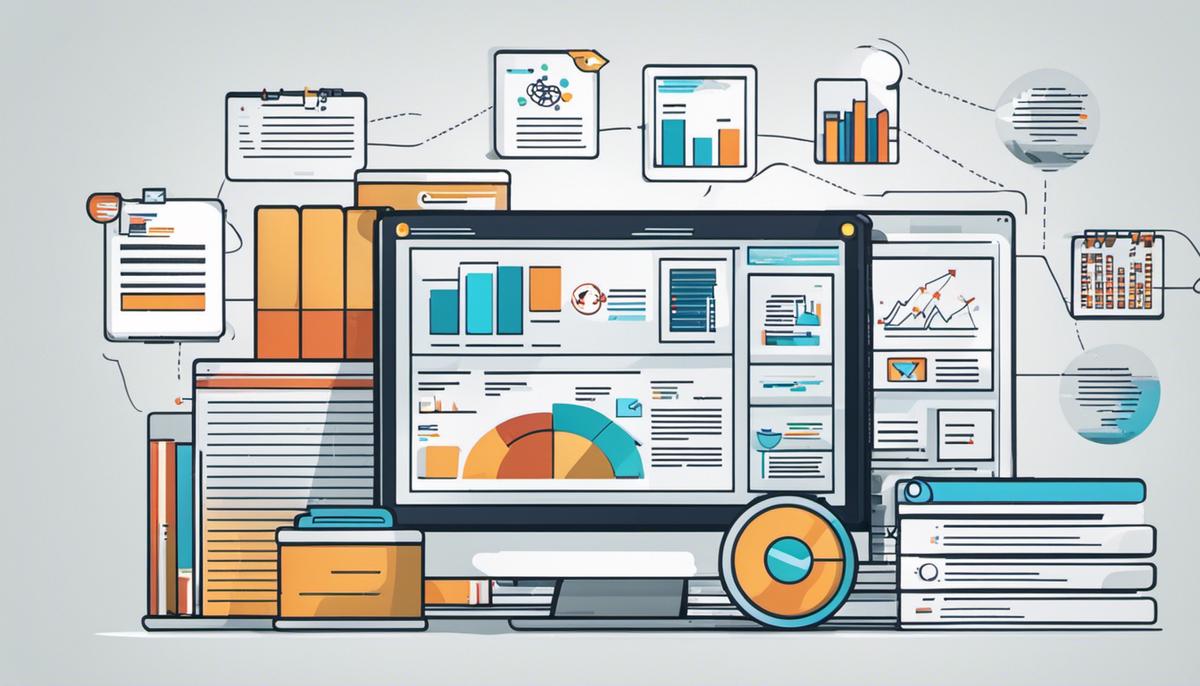In the vast, ever-changing landscape of digital content management, the emergence of a headless CMS (Content Management System) presents fresh, innovative ways of handling and distributing content. This distinctive system has reimagined the traditional approach by separating the front-end from the back-end, engendering a more agile, responsive, and scalable framework. The headless CMS, given its API-centric nature, assures wider applicability, flexibility, and remarkably enhanced performance. This article delves into the entrails of headless CMS, its structure, operation, and unique characteristics. Additionally, it scrutinizes its advantages, potential drawbacks, applications, and future trends. As we navigate the complexities of this system, the objective is to provide a comprehensive comprehension of the benefits and challenges a headless CMS presents in our increasingly digitized societies.
Understanding Headless CMS
Headless CMS: A New Trend in Content Management, Redefining the Digital Experience
In a rapidly evolving technology landscape, older concepts rub shoulders with the new, leading to a constant cycle of innovation. One arena where this is evident is in website development, specifically Content Management Systems, or CMS. A CMS, essentially, is a software platform that allows for creation, modification and management of digital content.
Riding in on the wave of modern trends is the Headless CMS, a newer variation that is beginning to transform the digital arena. But what is Headless CMS and how does it stand apart from traditional CMS? That’s exactly what we’re going to delve into.
Understanding Headless CMS
Headless CMS is essentially a back-end only content management system. It’s constructed as a content repository, making content accessible through RESTful APIs for display on any device. Therein lies one of its key selling points – the ability to deliver content anywhere and everywhere.
In tech-speak, the ‘head’ in CMS terminology is the front-end system where presentations are defined. Hence, a ‘headless’ CMS implies the lack of a defined presentation environment. The headless CMS, therefore, hands over full control of the content presentation to the developer via API calls.
Traditional CMS vs Headless CMS: A Comparative Analysis
A traditional CMS is built on a monolithic architecture where the content creation and its presentation are tightly integrated. It includes a pre-defined front-end delivery layer, or the ‘head‘, which displays content on a website.
On the other hand, a headless CMS follows a decoupled architecture, solely focused on storing and delivering structured content. It doesn’t care how and where the content is displayed, leaving that up to the developer.
Let’s view this distinction under a few more lenses.
Platform Agnostic:
- Since there are no restrictions regarding content presentation in a headless CMS, it’s platform-agnostic as the content can be served to any device. The traditional CMS, however, is less flexible as it’s bound to the server-side-rendered front-end.
Developer-friendly:
- Headless CMS offers a more liberated playground for developers allowing them to use any preferred framework or technology. Traditional CMS confines them to certain templates and coding practices.
Scalability:
- With headless CMS, the front-end and back-end are separated. This means one can scale either end independently, making it a great choice for large-scale applications. Whereas the scalability in traditional CMS is limited.
Future-proof:
- Headless CMS is a more future-proofed solution as it allows for integrating new technologies without overhauling the complete system. While in traditional CMS, you may need a complete system upgrade if you’re to incorporate new technologies.
While these advantages seem to strongly favor the headless approach, circumstances dictate choices. One must also consider factors like the project size, budget, target audience, long-term goals, and technical capacity when making a humane choice between the two. Innovation in the tech world is ongoing, and certainly, the saga between the present and future of CMS is far from over.

Advantages and Applications of Headless CMS
The landscape of digital experience and content management has undeniably been disrupted with the advent of a headless Content Management System (CMS). Beyond the plethora of advantages we’ve already explored, let’s look at the applications of this technology and delve deeper into the advantages it offers to organizations.
Arguably, the most profound advantage of a headless CMS is its flexibility and adaptability. It allows developers to build experiences for any user interface using any coding language, paving the way for limitless creativity and innovation. This open canvas approach is a boon in an era where new devices and interfaces are regularly hitting the market, offering tech enthusiasts a broader arena to experiment and apply their skills.
Marketing teams also stand to gain significantly from the headless CMS approach. With the ability to manage content in one place while pushing it across various channels, marketers can maintain cohesive messaging and branding. They can also easily update content, ensuring that marketing campaigns are always fresh and up to date.
Next up is the advantage of saving resources. With a traditional CMS, you are limited by pre-existing templates and structures. This often requires hiring specialized developers with niche expertise in certain languages. Headless CMS eliminates that necessity. Any developer can work on the system, consequently decreasing the resource and time costs of finding specialized talent.
The security benefit of a headless CMS cannot be overstated. Since the content presentation layer is separated from the CMS, the risk of security breaches is markedly lower. Plus, the delivery API of a headless CMS only serves readable content and does not allow any changes to be made. The reduction in points of vulnerability makes for a much more secure platform.
Turning our attention to where headless CMS can be applied, the possibilities are continually expanding. A headless CMS is particularly valuable for organizations managing multiple brands, websites, or languages. It can also be of great potential to companies looking to scale, improve content delivery, or expand their digital presence.
Another fitting arena is the IoT (Internet of Things). From smart homes to wearable devices, the IoT landscape is vast, varied, and growing. A headless CMS allows companies to control IoT experiences seamlessly while ensuring that content is consistently updated and tailored to each unique device.
The e-commerce space is also leveraging the power of headless CMS to offer tailored and innovative digital shopping experiences. With its ability to seamlessly integrate with customer relationship management systems and marketing automation tools, a headless CMS can drastically improve personalization and user engagement.
In conclusion, a headless CMS presents a promising solution for the fast-paced, innovative, and continuously evolving tech world. Its flexibility, security, scalability, ease of management, and applicability to diverse areas add an undeniable heft to its position. As the digital landscape advances, it wouldn’t be far-fetched to expect further advancements in this CMS model that could revolutionize how organizations manage content. Cutting-edge, efficient, and dynamic, headless CMS – the future of content management.

Potential Pitfalls and Challenges in Implementing a Headless CMS
While a headless CMS offers multiple advancements in content management with its flexibility, scalability, and developer-friendly nature, incubating and employing it in the corporate ecosystem is not devoid of challenges. Its implementation can pose potential issues that users should be cautious of before making the switch from a traditional CMS.
When it comes to implementing a headless CMS, the initial cost of transitioning can present a roadblock. Integrating a new system into existing infrastructure is often considered an expensive endeavor. Since headless CMS calls for more development work on the front-end, it may result in elevated expenses that startups and small businesses might not be able to manage.
Then there’s the potential issue of complexity. While the developer-friendliness of headless CMS can be a boon for developers, the lack of a front-end might complicate things for non-technical individuals. Manageability becomes a concern since routine tasks such as updating the website content could require a developer’s assistance. Users without a technical background can face its steep learning curve, and the consequent challenge it presents to efficient content management.
Another issue that targeted audiences could face would pertain to SEO. Traditional CMS has built-in SEO capabilities that optimize the site’s visibility, while a headless CMS may lack these. Remember, a headless CMS provides the content, but displaying it in an SEO-friendly manner on the front-end is a different ball game altogether. Implementation of SEO becomes a manual task that requires the expertise of SEO specialists or developers well-versed in this subtlety.
Unquestionably, security is paramount in the digital realm. While a headless CMS might, on the surface, seem more secure due to the separation of concerns, this doesn’t mean it is immune to cyber threats. The APIs crucial for a headless CMS might be potential security loopholes if not adequately secured, thus increasing the chances of hacker intrusions.
Lastly, while the focus has been majorly on content management, user experience (UX) can be inadvertently left to take the back seat. Since there is no built-in front-end in a headless CMS, UX design depends solely upon the expertise of the front-end developers. The result could be a disjointed or confusing user experience if not handled diligently.
In conclusion, while headless CMS certainly opens up new realms of possibilities in content management and scalability, potential roadblocks can hamper its effectiveness. Awareness of these challenges can guide users in making informed decisions: whether the switch from a traditional CMS to a headless CMS aligns with their needs, capacities, and long-term objectives.

Future Trends and Developments in Headless CMS
Looking into the crystal ball of the technology world, one can predict some exciting future developments in the realm of headless CMS. Being a cutting-edge evolution in the web content management ecosystem, headless CMS has stirred quite a buzz. Its benefits are hard to rival, but how does the future look for this technology? What trends can we anticipate? Let’s fast forward to the future.
Perhaps one of the most pivotal game-changers in the headless CMS universe is the role of artificial intelligence and machine learning. Given the headless CMS’s adaptability and scalability, coupling it with AI holds immense promise. Automated content optimizations, predicting user behavior, personalized user experiences—the possibilities are limitless. Companies that leverage AI and machine learning with their headless CMS are set to redefine user experience norms.
Coupled with AI, the role of Big Data in headless CMS is another path-breaking trend. The mammoth amount of data churned out by businesses can be efficiently managed by a headless CMS. Content strategists can sift, sort, and utilize relevant data to create personalized content, further improving the user experience.
The stride of voice search technology cannot be ignored. With the rise of smart home devices and digital assistants, content needs to be optimized for voice searches. Headless CMS, with its omni-channel ability, would play a crucial role in optimizing and delivering voice-optimized content, making it a promising future trend.
With tech evolving at warp speed, we can be sure about one thing—virtual and augmented reality will go mainstream, creating a need for VR/AR optimized content. Being format-free and built API-first, headless CMS is poised to cater to this demand, pushing it further up the trend ladder.
Headless commerce, a new offshoot of headless CMS, is gaining traction. In the future, expect to see businesses providing more customized shopping experiences, as a headless CMS facilitates a seamless customer experience irrespective of sales channel.
Lastly, the role of serverless applications is expected to grow. This could lead to a significant change in the way headless CMS is architected, leading to a decrease in latency and more efficient content delivery.
In conclusion, the times ahead are thrilling in the world of headless CMS. With the convergence of AI, voice technology, serverless applications and VR/AR, the future is indeed promising. It’s pivotal to remain on top of these trends to harness the untapped potential of headless CMS fully. Get ready to buckle up and embrace these technological advancements in the headless CMS world for a ride into the exciting future.

With a focus on giving you a proficient understanding of a headless CMS, we have dissected its structure, advantages, potential pitfalls, and the future developments that could influence its trajectory. The growing preference and enthusiasm for a headless CMS across different industries indicate towards it being a significant player in the future of digital content management. Its flexibility, scalability, and suitability for omnichannel distribution lend it an edge over traditional CMS. However, the system isn’t without its challenges, and understanding these can help organizations implement it more effectively. Embracing the headless CMS could well be the key to unlocking unparalleled user experiences and innovative content delivery models, shaping our digital landscapes in the many years to come.






